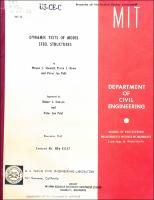Please use this identifier to cite or link to this item:
https://hdl.handle.net/11681/25605Full metadata record
| DC Field | Value | Language |
|---|---|---|
| dc.contributor.author | Pahl, Peter Jan, 1937- | en_US |
| dc.contributor.author | Rowe, Pierce Edward | - |
| dc.contributor.author | Stewart, Wayne Lee | - |
| dc.date.accessioned | 2017-11-27T15:42:09Z | en_US |
| dc.date.available | 2017-11-27T15:42:09Z | en_US |
| dc.date.issued | 1965-11 | en_US |
| dc.identifier.uri | http://hdl.handle.net/11681/25605 | en_US |
| dc.description | Research Report | en_US |
| dc.description.abstract | The objective of this research project is the development of modelling techniques for steel structures and an investigation of the effect of strain rate on the resistance function of structural elements. The work proceeded in four phases: a dynamic loading machine was developed, dynamic material properties were determined in a series of tensile tests, 16 static and dynamic tests were performed on simply supported beams loaded at the third points, and a series of 16 static and dynamic tests was performed on fixed ended portal frames subjected to a lateral load at the level of the girder. The dynamic loading machine is capable of rise times of 3 milliseconds or more and maximum loads of 2000 pounds. It can also be used as a static loading machine. The beam tests indicate that the resistance function in bending, for SAE 1113 steel models of 8 WF 67 sections is essentially independent of the strain rate. An equivalent single degree of freedom system yields good predictions of the experimental deflection-time curves for the beams. The consistency of tests on essentially identical beams is good. Tests on SAE 1020 steel models of 14 WF 103 beams indicate that for this steel,the resistance function in bending is strain rate dependent. The frame tests confirm the observations made during the beam tests. The resistance function of frames manufactured from SAE 1113 steel is essentially independent of the strain rate, and the theoretically predicted and experimentally observed static load-deflection curves are in good agreement if the flexibility of the base and the knee connection are accounted for. The average relative fixity of the frames at their base is in excess of 90%. Repeated tests on essentially identical frames are consistent, and a dynamic analysis based on an equivalent single degree of freedom system yields good predictions of the experimental deflection-time curves. Generally, it is concluded that model studies of steel structures provide an excellent experimental tool. Very sensitive tests for the investigation of strain rate effects have been developed. The necessary apparatus and techniques have been refined and initial difficulties eliminated so that a large number of additional tests on models with a variety of geometric configurations and material properties could be performed rapidly and reliably. These tests might significantly extend our understanding of the dynamic behavior of steel structures. | en_US |
| dc.description.sponsorship | Naval Civil Engineering Laboratory (Port Hueneme, Calif.) | en_US |
| dc.language.iso | en_US | en_US |
| dc.publisher | Massachusetts Institute of Technology | en_US |
| dc.relation.ispartofseries | Massachusetts Institute of Technology. Research Report,;R65-32 | en_US |
| dc.rights | Approved for public release; distribution is unlimited. | en_US |
| dc.source | This Digital Resource was created from scans of the Print Resource. | en_US |
| dc.subject | Structural dynamics | en_US |
| dc.subject | Steel, Structural--Testing | en_US |
| dc.title | Dynamic tests of model steel structures | en_US |
| dc.type | Report | en_US |
| Appears in Collections: | Research Report | |
Files in This Item:
| File | Description | Size | Format | |
|---|---|---|---|---|
| Research Report R65-32.pdf | 10.68 MB | Adobe PDF |  View/Open |